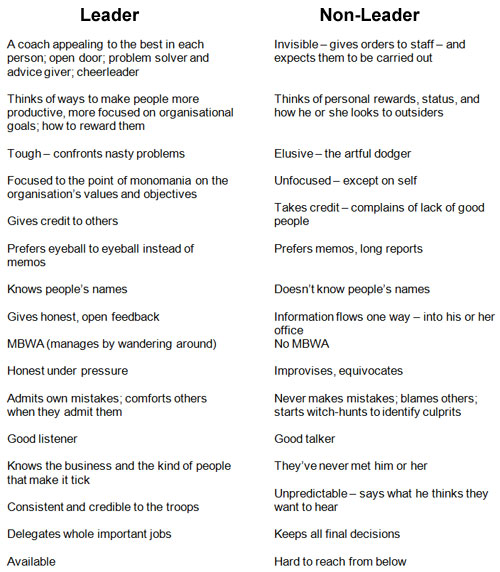2.3.1 Dot Points Of Leadership
More must have been written on leadership than just about any other management topic. Yet despite the volume of knowledge and the claim that leadership is not an innate quality but one that can be learned, managers are far more likely to be found wanting in terms of managing people than they are in the “technical” or “business” aspects of their jobs.
One of the best summaries of leadership qualities was that compiled by Robert Townsend in his book “Further up the Organisation” published in 1984. Townsend was best known as the boss of Avis whose advertising made it a virtue of being No.2 to Hertz – “We’re Number 2 so we try harder”. Townsend was a great believer in “participative management “ and loved mocking and challenging the conventions of corporate management.
Under the title – “Is there a leader in your company?” - he contrasted a total of 50 characteristics in two columns headed “Leader” and “Non-leader”. There isn’t room to list all fifty but here is a selection.
Townsend ends the list by adding “you now know more about leaders and leadership than all the combined graduate business schools in America.”
Of the above attributes, which one would you pick as the most desirable leadership quality?
My vote goes to MBWA. Note that it’s not “management by marching around” or even “management by walking around”. It’s “management by wandering around”. “Wandering around” suggests a lack of specific purpose and no tight time schedule. It’s predicated upon a desire to listen and talk with the troops, to exchange views, to keep one’s finger on the pulse of the organisation. It’s not threatening because the leader is on the troop’s territory. It shows confidence and a lack of arrogance. In short, it’s leadership.
Reflecting on my own forty years of experience, I have rarely met a good people manager who was not also a good “technical manager”. The former seems to guarantee the latter because even if the manager lacks certain technical skills a) he or she is prepared to acknowledge the fact, and b) is willing to learn from and rely on others. Unfortunately, the opposite is not the case. Those who are technically competent can be so confident in their ability to “run the business” that they see no need to display and develop the characteristics listed in the left-hand column.
Lastly, there is a third type – regrettably. This is the person who is lacking in technical skills - and consequently confidence. The need to cover up their technical inadequacies – which, of course, are obvious to all – leads to behaviour associated with the right-hand column. This double minus doesn’t make a plus.
My final comment concerns leadership at the very top of an organisation. If the CEO, the Principal, the Senior Partner or the General Manager is a leader, it’s an odds on bet that those whom they promote will be leaders as well.





